Rocco Sinisgalli (born 1947) is an Italian art historian, writer and architectural theoretician. [1]
Rocco Sinisgalli (born 1947) is an Italian art historian, writer and architectural theoretician. [1]
Sinisgalli was born in Gallicchio, in the province of Potenza and was educated in an Italian classical Liceo. He received a degree for Architecture in 1973 in the University of Rome La Sapienza. He currently teaches and carries out his research at the Faculty of Architecture Valle Giulia in the University of Rome La Sapienza.
Sinisgalli has been a national coordinator of research throughout the Universities in Rome such as Trieste and Genoa. He also has been the director of a bilateral research program with France (Centre National de la Recherche Scientifique-Paris —Consiglio Nazionale delle Ricerche-Rome). As the scientist responsible for the Italian party, he organized the International Symposium in France on “'Desargues et son temps' (Paris - Lyon, 25–30 November 1991), where he was a member of the Paris committee for the examinations of the 'Doctorat dans l’Histoire de la Perspective.' Rocco Sinisgalli is a historian with a perspective view for arts, science and techniques. Appointed as a Raffaello Sanzio Academician in Urbino, he established the “International Center of Studies: Urbino e la Prospettiv in the same city. He is well known for works related to Ptolemy, Jordanus [ disambiguation needed ], Commandino, Guidobaldo Del Monte, Stevin, Borromini, Maurolico, Leonardo and Alberti; which aim to a better historical view for geometry and representation in art and architecture.
In 1986, Sinisgalli was responsible for the “Sezione Spazio” at the “Art and Science” Biennale in Venice. In 1990, he established «I lunedì della Prospettiva», a series of lecture on History of Perspective at the Swiss Institute in Rome. As a lecturer at the national and international symposia, he gave lectures in Italy and abroad, and received prizes and merits for his works.
Sinisgalli published twenty-three books. The following are in English:
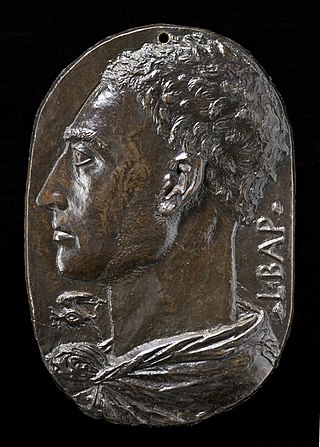
Leon Battista Alberti was an Italian Renaissance humanist author, artist, architect, poet, priest, linguist, philosopher, and cryptographer; he epitomised the nature of those identified now as polymaths. He is considered the founder of Western cryptography, a claim he shares with Johannes Trithemius.

Raffaello Sanzio da Urbino, now generally known in English as Raphael, was an Italian painter and architect of the High Renaissance. His work is admired for its clarity of form, ease of composition, and visual achievement of the Neoplatonic ideal of human grandeur. Together with Leonardo da Vinci and Michelangelo, he forms the traditional trinity of great masters of that period.

Filippo di ser Brunellesco di Lippo Lapi, commonly known as Filippo Brunelleschi and also nicknamed Pippo by Leon Battista Alberti, was an Italian architect, designer, goldsmith and sculptor. He is considered to be a founding father of Renaissance architecture. He is recognized as the first modern engineer, planner, and sole construction supervisor. In 1421, Brunelleschi became the first person to receive a patent in the Western world. He is most famous for designing the dome of the Florence Cathedral, and for the mathematical technique of linear perspective in art which governed pictorial depictions of space until the late 19th century and influenced the rise of modern science. His accomplishments also include other architectural works, sculpture, mathematics, engineering, and ship design. Most surviving works can be found in Florence.

Piero della Francesca was an Italian painter of the Early Renaissance. To contemporaries he was also known as a mathematician and geometer. Nowadays Piero della Francesca is chiefly appreciated for his art. His painting is characterized by its serene humanism, its use of geometric forms and perspective. His most famous work is the cycle of frescoes The History of the True Cross in the church of San Francesco in the Tuscan town of Arezzo.
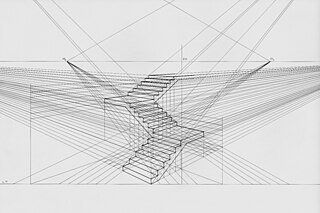
Linear or point-projection perspective is one of two types of graphical projection perspective in the graphic arts; the other is parallel projection. Linear perspective is an approximate representation, generally on a flat surface, of an image as it is seen by the eye. Perspective drawing is useful for representing a three-dimensional scene in a two-dimensional medium, like paper.
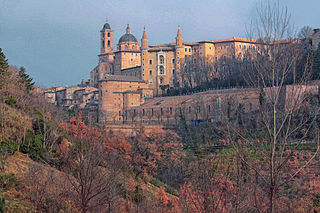
Urbino is a comune (municipality) in the Italian region of Marche, southwest of Pesaro, a World Heritage Site notable for a remarkable historical legacy of independent Renaissance culture, especially under the patronage of Federico da Montefeltro, duke of Urbino from 1444 to 1482.

Raffaello Morghen was an Italian engraver.

The Accademia di San Luca is an Italian academy of artists in Rome. The establishment of the Accademia de i Pittori e Scultori di Roma was approved by papal brief in 1577, and in 1593 Federico Zuccari became its first principe or director; the statutes were ratified in 1607. Other founders included Girolamo Muziano and Pietro Olivieri. The Academy was named for Luke the Evangelist, the patron saint of painters.

The Transfiguration is the last painting by the Italian High Renaissance master Raphael. Cardinal Giulio de Medici – who later became Pope Clement VII – commissioned the work, conceived as an altarpiece for Narbonne Cathedral in France; Raphael worked on it in the years preceding his death in 1520. The painting exemplifies Raphael's development as an artist and the culmination of his career. Unusually for a depiction of the Transfiguration of Jesus in Christian art, the subject is combined with the next episode from the Gospels in the lower part of the painting. The work is now in the Pinacoteca Vaticana in the Vatican City.
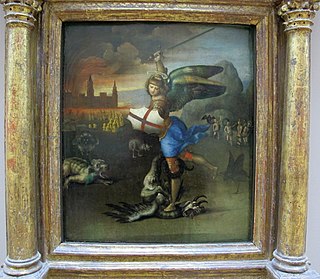
St. Michael Vanquishing Satan is a painting by the Italian High Renaissance artist Raphael. The image consists of the archangel Michael standing on top of Satan's back with his right foot. Both works have been located in the Louvre in Paris since 1667. The painting was commissioned by Pope Leo X.
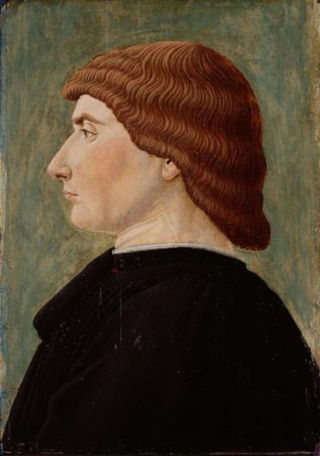
Fra Carnevale OP was an Italian painter of the Quattrocento, active mainly in Urbino. Widely regarded as one of the most enigmatic artists, there are only nine works that can be definitively attributed to Carnevale known of today. Most of these have even been contested as authentic to Carnevale at various points in history.
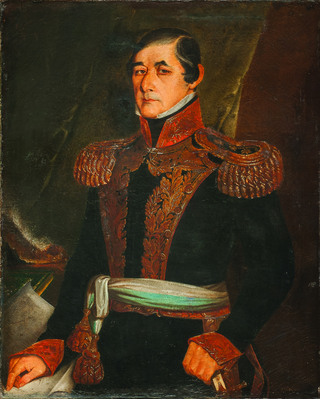
Baldassare Verazzi was an Italian painter.

De pictura is a treatise or commentarii written by the Italian humanist and artist Leon Battista Alberti. The first version, composed in Latin in 1435, was not published until 1450. It is one of his three treatises on art; the other two are De statua and De re aedificatoria, that would form the Renaissance concept for the fine arts: painting, sculpture, and architecture.
Montagnani is a surname. Notable people with the surname include:
The Ideal City is the title given to three strikingly similar Italian Renaissance paintings of unresolved attribution. Being kept at three different places they are most commonly referred to by their location: The Ideal city of Urbino, Baltimore, and Berlin. Hubert Damisch, who has written at length about the paintings, refers to them as the "Urbino perspectives" or "panels". The three paintings are dated to the late 15th century and most probably they have different authors but various attributions have been advanced for each without any consensus. There is also a discussion about the purpose of the paintings as they are all in an unusual elongated format. In 2012 the Baltimore and Urbino panels were shown at a joint exhibition, with the Berlin painting being represented by a copy, as the original is too fragile to be shipped abroad.

Raffaello Sorbi was a 19th-20th century Florentine painter, specializing in narrative painting.

Peter Geoffrey Barry Hicks is a British historian and church musician.
Mario Salmi was an Italian art historian and art critic who specialized in Romanesque architecture, Tuscan sculpture and the early Italian Renaissance.
Franco Borsi (1925–2008) was an Italian architect and architectural historian. He was professor of history of architecture at the University of Florence, and wrote on Giovanni Michelucci, Leon Battista Alberti, Gian Lorenzo Bernini and Donato Bramante.

Pietro Paolo MontagnaniakaPietro Paolo Montagnani-Mirabili is a late 18th C. - early 19th C. Italian engraver (burin) and publisher of books and prints who lived presumably in Florence, Italy, around 1800 - 1820.